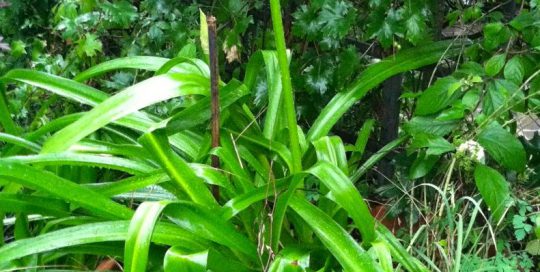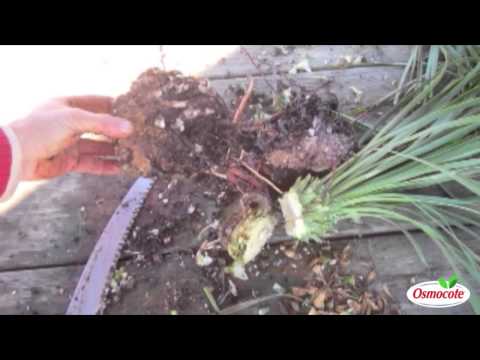Big Homes, Wild Gardens
Views: 5693

This week I’m working in Charleston SOB (South of Broad), where bazillion dollar houses have, for the most part, really boring gardens!
Referring to one of those gardens, a friend recently told me, “Why, her garden is so neat and clean, I’d be happy to have my surgery there!” But Roger Tenant Jr. and Erik Healy, Moore Farms horticulture interns, are getting a face full of wild!
I want WILD gardens, masterfully controlled so the garden stays a garden, but WILD! Where the plants take advantage of Sundays 100 degrees high and Sunday nights 98-degree low. Where plants suck up all this rain and sunshine and turn them into green, yellow and purple life sprawling onto the sidewalk and twining into the windows.
I remember an old lady of my childhood who’d train the wisteria that came in the cracks around her kitchen window, over the sink and along the shelves. I remember Doug Ruherens killer garden in Durham, where palms grew up through the porch floorboards. Man, the romance of the deteriorating south is based on WILD, on our laying back (for whatever reason) and getting covered up with green.
I remember Ruth Knopf, with her wildflowers and antique roses around the house where I’d stay. The bedroom was two screen porches away from the bathroom!
What’s the work?
Seed in for late summer. I scattered Cosmos Psycho White in a bed that is mostly dying Arugula. The Arugula will shade the seedlings now and in July Ill have flowers.
Seed in agricultural crops. I seeded Millet, and Sorghum, and my friend, Brian Gandy, seeded cowpeas and buckwheat this week. Bring a little country farm into your yard!
Kill the Cannas Bugs! With apologies to all my Buddhist friends, I kill those damned Cannas -eating larvae that leave webs, holes and brown spots. I just cut them off, put them in a plastic bag and dump in the trashcan. In the garden, use Merit, a systemic, easy-to-apply insecticide.
READ. My favorite book of the season is The Wirtze Garden by Patrick Taylor. Its expensive so you may want to ask your local library to do an inter-library loan for you.
What’s looking WILD in the Gardens
Artemisia ludoviaiana (Western Mugwort or White Sagebrush) Did we talk about this before? Well, lets do it again if we did. Tall silver canes that stand up and march across the border, lightly shading but not killing the daylilies, yuccas and ferns along the way. Poor soil, full sun, and minimal moisture are its friends, but it can spread aggressively.
Scuppernongs. There is no better vine around for making us remember the romance of childhood. The smell, the beautiful pest-free leaves and yellow fall color all remind me of growing up in the South. My vine is trained on the lattice fence behind my perennial border and constantly tries to get into a nearby jelly palm. Did you know that the scuppernong is the state fruit of North Carolina and that it takes its name from a lake, town, and river all named Scuppernong? Cuttings from the mother plant ion Roanoke Island, North Carolina are said to have been taken to this area in the 17th and 18th centuries. Wine, jam, fruit, enchanting small and fall color- how can you not plant this one?
Even More Blooms
Ptillmnium capillaceau (Mock Bishop Weed) Why fight the weeds? Lets encourage them! This one looks great when paired with purple-headed Alliums. Its like a tine Queen Annes Lace that comes back every year and makes for a frothy show in June. A member of the carrot family, it has tine white flowers and no scent, but its foliage grows 1-3 feet high and makes a beautiful fragile display. It likes to have a constant washing of its roots, so it often found in running streams or wet meadows.
Asparagus Officinalis I read somewhere recently that if you dont want asparagus seedlings coming up everywhere, you should pick out and destroy the female plants! Its just like Aliens! I think its better to let these airy beauties come up where they may, and then pull out the ones that come up where they cause a problem. This herbaceous, erect plant with alternate scale-like leave usually grows from 40-60 inches tall and is a great companion plant for tomatoes as they repel the asparagus beetle. Plant the crowns in winter and look for the early shoots in spring.
Siphium perfolatum (cup plant) What a sweet monster! I got mine from my friend Erics garden a few days after his funeral. Eric never cut back things the way he should have, so you had to duck under this for months. His sometimes grew up to 8 feet tall, and thats not so unusual.. The course leaves on opposite sides of the course stalk form a cup of sorts that holds water. Hence the common name.
Meet Jenks Farmer
Jenks's Recent Posts

Beans: A Nurse Crop for Perennials








